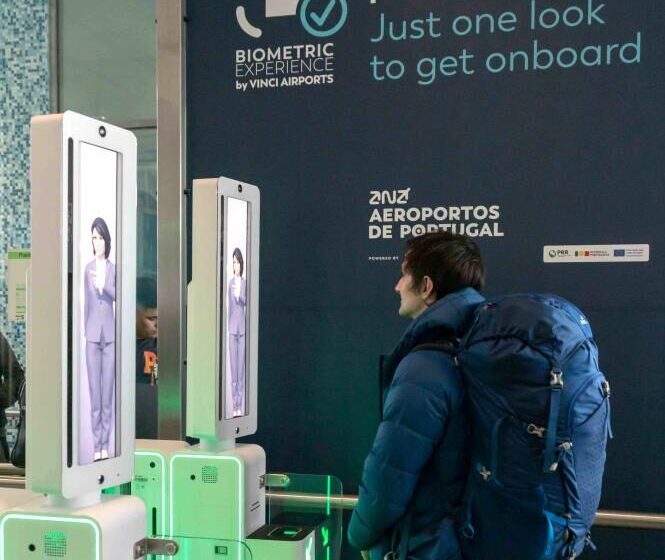Airports 4.0 – Biometric Identification at Lisbon and Oporto Airports

At the beginning of 2024, the installation of biometric identification equipment at Lisbon and Oporto Airports was announced. This cutting-edge technology, which is a testament to their commitment to innovation and efficiency in air travel, will not only streamline passenger processes but also elevate security standards, ensuring a seamless journey for travellers.
VTM therefore takes this opportunity to recognize the excellent work carried out by the Lisbon and Oporto Airports and, of course, by our esteemed client ANA Aeroportos de Portugal, the entity that manages most Portuguese airports. These recent news are symbolic of a great milestone in enhancing passenger experience and taking one more step towards fully transforming into Airports 4.0.
Hence, to provide a better understanding of the concept of Airport 4.0, VTM seizes this opportunity to provide a brief explanation below to those who are as interested as we are in this topic.
Airport 4.0
Through the analysis of different scientific articles, particularly by authors Roberto da Silva & Konarzewski (2022), it is quite easy to understand the origin of the term Airport 4.0 and its respective concept definition. These authors start by referring to the literature of Halpern et al. (2021), which defines the various evolutionary phases that an airport can go through depending on the degree of its digital transformation process:
- In the first phase, Airport 1.0 is mostly analogue, with most processes being carried out manually, which delays data collection and process execution.
- In the second phase, the evolution to Airport 2.0 already brings the use of some digital technologies in airport processes, such as check-in, security, or passenger information.
- Airport 3.0 is already mostly digitized, with digital technologies playing a leading role in most airport processes, significantly used to add value to processes and facilitate decision-making.
- Finally, Airport 4.0 is an infrastructure that is considered to have completed its digital transformation process. In Airport 4.0, data collection is extremely efficient, and the use of this data adds value to airport processes and can even be processed and shared with stakeholders in real-time through intelligent technological resources.
(Halpern et al., 2021)
Thus, Roberto da Silva & Konarzewski (2022) define Airport 4.0 as a smart airport, whose concept is based on not only using technology for constant and extremely efficient data collection but also using that data strategically, with real-time analysis, decision-making, and information sharing. This type and quantity of collected data, as well as their respective use, can contribute to operational improvements in airport management and optimization, by allowing a much deeper understanding of passenger behaviours (Alabsi & Gil, 2021).
To this definition, Roberto da Silva & Konarzewski (2022) also add that, according to SITA (2021), there are three essential aspects for an airport to be considered smart: the type of infrastructure and technology used, which is integrated into digital systems that enable data sharing and resource management in real-time, and finally, that materialize these same characteristics in smart solutions. Additionally, the authors further add that a fundamental component is the capacity for integration, including the integration of digital systems that are completely independent of each other in their genesis and development, as well as integration with smart cities located in the vicinity of these 4.0 airports.
Additionally, in another scientific article analyzed, Tan & Masood (2022) also conducted a literature review in search of a conceptual definition of Airport 4.0. In their study, these authors concluded that the concept aims to capture the new digital era of airports, also highlighting the ability to analyze data as an essential characteristic of a smart airport. Also, similar to the previously analyzed article, the authors refer to the literature of Zaharia & Pietreanu (2018) with the mention that 4.0 airports allow for efficiency improvements in airport operations, promote improvements in the passenger experience, and additionally generate additional ancillary revenues.
Benefits associated with Airports 4.0
Through the definitions above, it is already possible to begin to understand the benefits associated with this type of infrastructure, mainly regarding economic and social sustainability. Thus, the following briefly presents the framing of smart airports in the three main pillars of sustainability: economic, social and environmental.
Economic Sustainability – The economic aspect of Airport 4.0 is evidenced by the potential impact on strategic plans and operational performance of airports and even their contributions to the economy of the region/country where the airport is located. One of the aspects that stands out in the previous paragraphs is the operational improvements that can arise from the digital transformation process of an airport, which can contribute to optimizing the allocated resources with a consequent cost reduction, as well as generating additional revenues through the analysis of passenger profile data. The following are some practical examples that demonstrate the contribution of smart airports to economic sustainability:
- Use of technologies such as RFID (Radio Frequency Identification) and IoT (Internet of Things) to improve baggage tracking and reduce handling errors, thus improving overall operational efficiency and associated costs.
- Use of AI (Artificial Intelligence) algorithms in air traffic management to optimize runway usage and increase airport capacity, and reduce costs associated with delayed flights.
- Real-time, in-depth analysis of passengers that allow airports to personalize retail and catering offerings as well as conduct more targeted advertising, maximizing airport revenues.
- Implementation of blockchain technology in airport retail to increase transaction transparency and control, attracting more partners and diversifying payment methods, such as through cryptocurrencies.
- Among others.
Social Sustainability – The social aspect of Airport 4.0 is mainly related to the responsible management of the socio-economic consequences arising from airport operations and, moreover, with the direct impacts on society and the well-being of passengers. Thus, the social sustainability of smart airports is evident in the impacts of airport operations on the living conditions of the local population and in the perception that passengers have of the airport infrastructure as users. Some practical examples of the applicability of digital transformation in this social aspect are:
- Improvement of the passenger experience through, for example, biometric identification technology such as that being implemented at Lisbon and Oporto Airports (Diário de Notícias, 2024). This technology uses tools such as facial recognition to streamline the various airport processes to which passengers are subjected, reducing waiting times and improving the passenger experience.
- Real-time updates with information about flights and airport services through mobile applications, which also contribute to a better passenger experience.
- Adoption of intelligent signage through augmented reality technologies, which allow better guidance of passengers and even allow passengers with reduced mobility (e.g., visually impaired passengers) to move more independently.
- Innovation in airport design principles to adopt a more inclusive architecture that responds in real-time to passenger needs.
- Optimization of resources and consequent promotion of energy efficiency (which will be further explored later) contribute to an improvement in the quality of life of airport workers and the populations installed in the airport perimeter.
- Among others.
Environmental Sustainability – The environmental aspect of Airport 4.0 refers to the ability to reduce the harmful environmental impact of airport activities, including aspects such as minimizing air pollution, reducing noise, and optimizing water and electricity consumption, which are typically high in airports. Some examples of environmental initiatives enabled by the digital transformation of airports are:
- Use of energy efficiency technologies, such as smart lighting systems and energy management platforms, to minimize consumption (which also represents, simultaneously, an improvement in social and economic terms).
- Incorporation of renewable energy sources, such as solar panels and wind turbines, whose optimization can be achieved through real-time adaptation to atmospheric conditions with advanced technologies.
- Adoption of environmentally sustainable projects, with ecological materials and new technologies that allow management oriented towards reducing the carbon footprint.
- Implementation of electric buses and charging stations or a fleet of state-of-the-art airport vehicles, aimed at reducing environmental pollution.
- Acquisition of smart trash cans equipped with sensors that allow optimization of waste collection routes, reducing fuel consumption and improving overall waste management efficiency.
- Use of smart aircraft, with sensors capable of capturing and analysing data in real-time to improve energy consumption and minimize the impacts of aircraft passages in regions with higher population density.
- Among others.
Brief examples
When looking for practical examples and case studies related to smart airports (Airports 4.0), it is sufficient to focus on airports at the forefront of technology and innovation. In this context, the two most frequently mentioned examples are Changi Airport in Singapore and Dubai International Airport (Global Infrastructure Hub, 2024). For example, it should be noted that Singapore Airport is integrated with technologies including sensors, data analysis, and artificial intelligence to improve the passenger experience and increase productivity, and furthermore, has already implemented a blockchain-based digital wallet (Global Infrastructure Hub, 2024).
Other relevant examples of airports that can already be framed in this Airport 4.0 context are cases such as London Airport (UK), New Delhi (India), Beijing (China), or Atlanta (USA), with the latter often seen as an international benchmark. As for Lisbon and Oporto Airports, with the implementation of the biometric identification technology mentioned in this article, they are also beginning to position themselves and fully transforming towards the concept of smart airports.
References
- Alabsi, M. I., & Gil, A. Q. (2021). Review of Passenger Digital Information Privacy Concerns in Smart Airports. IEEE Access, 9, 33769–33781.
- Diário de Notícias. (2024). Aeroportos de Lisboa e Porto implementam solução biométrica facial nas partidas. Downloaded from: www.dn.pt
- Global Infraestructure Hub. (2024). Smart Airports. Downloaded from: https://cdn.gihub.org/umbraco/media/3599/45-Smart-Airports.pdf
- Halpern, N., Mwesiumo, D., Suau-Sanchez, P., Budd, T., & Brathen, S. (2021). Ready for digital transformation? The effect of organizational readiness, innovation, airport size and ownership on digital change at airports. Journal of Air Transport Management, 90.
- JM Madeira (2024). Aeroportos de Lisboa e Porto apostam na inovação com nova solução biométrica dedicada aos passageiros. Downloaded from: www.jm-madeira.pt
- Roberto da Silva, J., & Konarzewski, K. A. (2022). Aeroportos Inteligentes: O Embarque para o Futuro. Revista Brasileira de Aviação Civil & Ciências Aeronáuticas, 2(1), 7–24.
- SITA. (2021). Société Internationale de Télécommunications Aéronautiques. Downloaded from: www.sita.aero
- Tan, J. H., & Masood, T. (2022). Airport 4.0: Technology Adoption Framework for Airports (TAFA).
- Zaharia, S. E., & Pietreanu, C. V. (2018). Challenges in airport digital transformation. In Transportation Research Procedia (Vol. 35, pp. 90–99).
Latest news
All news
New study reveals how street network layout shapes urban mobility cultures across Europe
A collaboration including VTM’s Cristian Adorean uncovers fresh insights into the relationship between city design and travel behaviour. A new study published in Cities examines how the layout of street networks—measured as “circuity”—relates to varied mobility cultures across 41 European cities. Co-authored by VTM senior consultant Cristian Adorean, the research explores how urban environments shape […]

Key challenges to widespread adoption of clean hydrogen in urban mobility: a chicken-and-egg problem?
This is the third article of a trilogy about the application of hydrogen technologies in transport. The first one and the second one are still accessible on our website. Our previous article briefly introduces the tech under the hood of fuel cell vehicles (FCV) and their main advantages over battery electric vehicles (BEV). Depending […]
